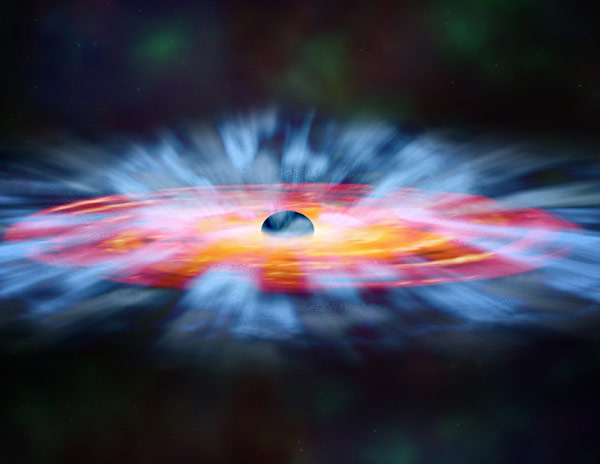Despite Rumors, Black Hole Factory Will Not Destroy Earth

Scientists could generate a black hole as often as every second when the world's most powerful particle accelerator comes online in 2007.
This potential "black hole factory" has raised fears that a stray black hole could devour our planet whole. The Lifeboat Foundation, a nonprofit organization devoted to safeguarding humanity from what it considers threats to our existence, has stated that artificial black holes could "threaten all life on Earth" and so it proposes to set up "self-sustaining colonies elsewhere."
But the chance of planetary annihilation by this means "is totally miniscule," experimental physicist Greg Landsberg at Brown University in Providence, R.I., told LiveScience.
Black holes possible
The accelerator, known as the Large Hadron Collider, is under construction in an underground circular tunnel nearly 17 miles long at the world's largest physics laboratory, CERN, near Geneva.
Black holes are among a handful of threats to the planet. But Earth is more resilient than you might think. >>>
At its maximum, each particle beam the collider fires will pack as much energy as a 400-ton train traveling at 120 mph. By smashing particles together and investigating the debris, scientists hope to help solve mysteries such as the origin of mass and why there is more matter than antimatter in the universe.
If theories about the universe containing extra dimensions other than those of space and time are correct, the accelerator might also generate black holes, Landsberg and his colleague Savas Dimopoulos at Stanford University in California calculated in 2001. Physicists Steve Giddings at the University of California, Santa Barbara and Scott Thomas at Stanford University in California reached similar conclusions.
Sign up for the Live Science daily newsletter now
Get the world’s most fascinating discoveries delivered straight to your inbox.
Black holes possess gravitational fields so strong that nothing can escape them, not even light. They normally form when the remains of a dead star collapse under their own gravity, squeezing their mass together. Although black holes can't be seen, astronomers infer their existence by the gravitational effects they have on gas and stars around them.
Making black holes
A number of models of the universe suggest extra dimensions of reality exist that are each folded up into sizes ranging from as tiny as a proton, or roughly a millionth of a billionth of a meter, to as big as a fraction of a millimeter. At distances comparable to the size of these extra dimensions, gravity becomes far stronger, these models suggest. If this is true, the collider will cram enough energy together to initiate gravitational collapses that produce black holes.
If any of the models are right, the accelerator should create a black hole anywhere from every second to every day, each roughly possessing 5,000 times the mass of a proton and each a thousandth of a proton in size or smaller, Landsberg said.
Still, any fears that such black holes will consume the Earth are groundless, Landsberg said.
For one thing, theoretical physicist Stephen Hawking calculated all black holes should emit radiation, and that tiny black holes should lose more mass than they absorb, evaporating within a billionth of a trillionth of a trillionth of a second, "before they could gobble up any significant amount of matter," Landsberg said.
Not destroyed yet
CERN spokesman and former research physicist James Gillies also pointed out that Earth is bathed with cosmic rays powerful enough to create black holes all the time, and the planet hasn't been destroyed yet.
"Still, let's assume that even if Hawking is a genius, he's wrong, and that such black holes are more stable," Landsberg said. Nearly all of the black holes will be traveling fast enough from the accelerator to escape Earth's gravity. "Even if you produced 10 million black holes a year, only 10 would basically get trapped, orbiting around its center," Landsberg said.
However, such trapped black holes are so tiny, they could pass through a block of iron the distance from the Earth to the Moon and not hit anything. They would each take about 100 hours to gobble up one proton.
At that rate, even if one did not take into account the fact that each black hole would slow down every time it gobbled up a proton, and thus suck down matter at an even slower rate, "about 100 protons would be destroyed every year by such a black hole, so it would take much more than the age of universe to destroy even one milligram of Earth material," Landsberg concluded. "It's quite hard to destroy the Earth."
If the Large Hadron Collider does create black holes, not only will it prove that extra dimensions of the universe exist, but the radiation that decaying black holes emit could yield clues that help finally unite all the current ideas about the forces of nature under a "theory of everything."










